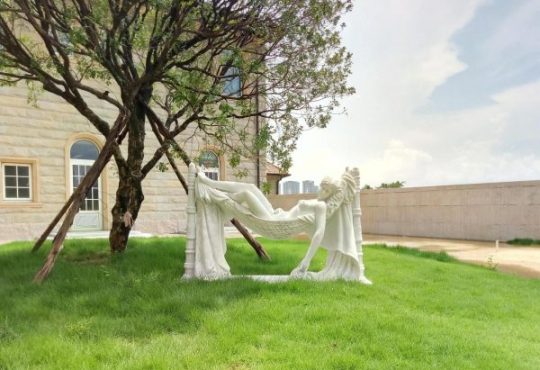Hidden just behind Palazzo Sorricchio in the heart of Atri, Abruzzo, the Giardino Ducale Nicola e Luigi Sorricchio emerges as a vibrant chronicle woven from centuries of human endeavor. Long surrendered to neglect and overgrowth, this Renaissance-inspired garden has been spectacularly revived and recrafted by Hadrianum S.r.l. Into the “Garden of the Renaissance,” it now stands as both a cultural beacon and a communal sanctuary, where artistry, civic legacy, and historical memory converge. Yet beneath its manicured lawns and elegant pathways lies a deeper story: traces of ancient Roman life endure in cisterns, civic structures, and perhaps even a hidden ginnasio, quietly anchoring the garden to a foundation that spans millennia.
What appears today as a manicured landscape of symmetry and serenity was once a bustling Roman forum, later adapted into an arena for equestrian exercises under the rule of the Dukes of Atri. Over time, it evolved into a formal Italianate garden, complete with ornamental water features and meticulously structured layouts. Saved from oblivion by the dedication of historians Nicola and Luigi Sorricchio, who documented its past in detailed writings and manuscripts, the site has experienced a revival rooted not only in restoration but in renewed purpose as a gathering space for culture, learning, and connection.
Hidden Origins Beneath the Surface
Nestled in the heart of Atri, the Giardino Ducale appears at first glance as a picture of Renaissance grace, yet beneath its meticulously trimmed hedges and elegant pathways lies a tapestry of history that stretches back millennia. The garden occupies land that once formed part of the ancient Roman city of Hatria, where archaeological investigations have uncovered traces of baths, cisterns, and perhaps even a gymnasium. These subterranean relics whisper stories of daily life in Roman times—the routines, leisure, and civic rituals of a long-vanished populace—anchoring the garden not merely in aesthetic appeal but in a deeply rooted historical continuum.
Over the centuries, the Dukes of Atri appropriated this civic space, transforming it into an arena for equestrian training, ceremonial displays, and aristocratic gatherings. The garden evolved into a stage where utility and pageantry coexisted, blending Roman practicality with Renaissance grandeur. Today, the Giardino Ducale stands as a living palimpsest: its manicured lawns and ornamental structures subtly honor the layered legacy beneath, offering visitors a serene yet resonant glimpse into centuries of human endeavor, adaptation, and refinement.
An Aristocratic Canvas: From Civic Space to Ducal Garden
During the Renaissance, the Giardino Ducale underwent a profound transformation, reflecting the era’s fascination with order, beauty, and intellectual expression. The garden was redesigned in the classic Italianate style, with a strict emphasis on symmetry, ornate fountains, and meticulously trimmed vegetation. Every winding path, tiered terrace, and meticulously sculpted hedge was crafted not only to delight the senses but also to project prestige, refined taste, and cultivated sophistication—an enduring expression of Renaissance ideals brought to life through the landscape. This metamorphosis echoed a broader European trend in which formerly utilitarian or civic spaces were reimagined as symbolic landscapes, where architecture, horticulture, and art converged to create statements of prestige and cultural aspiration.
Ownership of the garden eventually passed into the hands of the Sorricchio family, whose stewardship ensured its continued prominence. Nicola Sorricchio, an 18th-century historian and public official, meticulously documented the garden’s features, integrating it seamlessly with the adjacent Palazzo Sorricchio and preserving its Renaissance character. Generations later, his descendant Luigi Sorricchio expanded upon this work in the landmark historical volume Hatria = Atri, a comprehensive chronicle tracing the city’s evolution from Roman antiquity through the medieval period. Through their scholarship and care, the Sorricchios safeguarded not only the garden’s physical beauty but also the layered narrative of its past, ensuring that its story endured across centuries.
Layers of Scholarship: Nicola and Luigi Sorricchio
Nicola Sorricchio was instrumental in safeguarding Atri’s cultural memory, dedicating his life to the meticulous transcription of ancient texts such as the Annali Acquaviviani. His careful preservation of these documents provided a foundation for later historians and remains an indispensable resource for understanding the city’s architectural, social, and civic evolution. Beyond his scholarly pursuits, Nicola held the esteemed municipal position of Mastro Giurato. This role placed him at the heart of Atri’s civic administration and reflected the breadth of his influence within the community. Through both his writings and public service, Nicola forged a legacy that anchored Atri’s past firmly in the present.
Carrying forward this intellectual torch, Luigi Sorricchio emerged in the early 20th century as a historian with a keen eye for both detail and context. With a background in the social sciences, he approached Atri’s Roman and medieval heritage with analytical rigor, producing work that combined scholarly precision with accessible insight. The publication of the first volume of Hatria = Atri in 1911 marked a turning point in local historical study: Luigi’s analysis not only illuminated the city’s complex past but also inspired renewed interest in archaeology, urban development, and cultural preservation.
His scholarship enriched the narrative tapestry of the Giardino Ducale and the city at large, ensuring that generations to come could engage with Atri’s layered history in both intellectual and experiential ways.
From Dereliction to “Garden of the Renaissance”
By the early 21st century, the Giardino Ducale had slipped into a state of near-abandonment. Choked by wild weeds, marred by debris, and severed from the echoes of its illustrious history, the garden appeared on the brink of being forgotten. Even after being placed under municipal care through a free loan agreement in 2004, neglect continued, fueling concern among local citizens and descendants of the families who had long maintained its legacy. The contrast between its Renaissance elegance and its dilapidated condition was stark, underscoring the urgent need for intervention.
The turning point arrived when Hadrianum S.r.l., led by visionary entrepreneur Piero Pavone, acquired the site from the Sorricchio and Arlini families and committed to a comprehensive private restoration. Over nearly four years, the team undertook meticulous work to breathe life back into the garden: debris was cleared, structural and architectural features were carefully repaired, and landscaping was thoughtfully redesigned to respect the site’s historical layers. The effort went far beyond superficial beautification; it was a full-scale resurrection, restoring not only the garden’s visual splendor but also its connection to centuries of civic, aristocratic, and scholarly heritage. Today, the Giardino Ducale stands as a living testament to resilience, history, and the enduring power of careful stewardship.
Cultural Revival Through Events
Restored to its full splendor, the Giardino Ducale Nicola e Luigi Sorricchio has reclaimed its place as a lively cultural heart of Atri. In June 2025, the garden came alive during Adriano Influencer ante Litteram, a creative homage to Emperor Hadrian. The program wove together live readings, academic discussions, and artistic displays, honoring the city’s Roman heritage while turning scholarly exploration into an accessible, immersive experience for all who attended.
These cultural events have helped reposition the garden as a dynamic platform for community engagement, learning, and celebration. Collaborations with historians, artists, and educational institutions continue to enrich its programming, solidifying its role as a living, breathing space for cultural storytelling.
Top Features and Significance
- Dual identity: The garden seamlessly weaves Roman archaeological remnants with Renaissance-era elegance, embodying centuries of civic evolution.
- Archaeological depth: Hidden beneath the surface are Roman cisterns and possibly remnants of ancient baths and a gymnasium.
- Equestrian heritage: Once used for ducal horse training, the garden was both a working arena and a ceremonial space.
- Renaissance Elegance: Characterized by its structured walkways, elaborate fountains, and harmonious proportions, the garden’s Italianate style captures the refinement and splendor of 16th- and 17th-century noble aesthetics.
- Nicola Sorricchio’s archival efforts: His manuscripts remain foundational in preserving the garden’s and the city’s architectural legacy.
- Luigi Sorricchio’s scholarship: Through his work in Hatria (Atri), he preserved historical continuity and provided lasting intellectual depth for generations to come.
- Private restoration initiative: Hadrianum’s fully funded effort reversed decades of neglect without public investment.
- Health and environmental rescue: The cleanup eliminated safety hazards and transformed the space into a sustainable green zone.
- Cultural programming: Events and lectures continue to reanimate the site, positioning it as a cultural and educational nucleus.
- Architectural synergy: The garden’s connection to Palazzo Sorricchio enhances its aesthetic and historical value.
- Public accessibility: Reopened during Italy’s FAI Autumn Days in 2020, the garden now welcomes visitors to explore its layered past.
- Digital access to archives: Sorricchio documents are now digitized, offering researchers remote access to critical historical materials.
- Educational initiatives: The garden hosts events that integrate heritage with learning, fostering intergenerational dialogue.
- Local pride: The restoration has ignited civic pride and encouraged broader conversations about historical preservation.
- Institutional challenges: Bureaucratic friction during restoration highlights the complexities of managing cultural heritage in Italy.
Reviving History Through the Giardino Ducale
The Giardino Ducale Nicola e Luigi Sorricchio tells a story far richer than its carefully clipped hedges and elegant pathways suggest. It narrates a saga of layered history—from Roman engineering and ducal traditions to academic preservation and community resurgence. Each step through its grounds connects visitors to centuries of evolution, struggle, and rebirth.
In reviving the garden, Atri has not only reclaimed a physical space but also reignited a sense of shared memory and civic identity. It stands as a model for how heritage, when embraced and invested in, can be transformed from a forgotten relic to a living legacy. As this once-silent garden now echoes with conversation, celebration, and discovery, it offers a powerful reminder: the past, when thoughtfully cultivated, can bloom brilliantly in the present.





